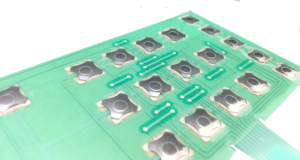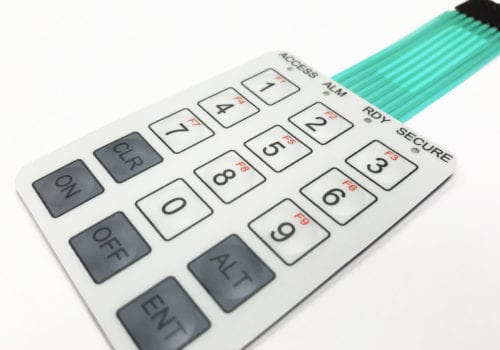The Duty of a Membrane Switch in Modern Touch Interfaces and Controls
The Duty of a Membrane Switch in Modern Touch Interfaces and Controls
Blog Article
Recognizing the Capability of Membrane Switches Over for Interface Devices
The performance of membrane switches represents a considerable development in interface layout, incorporating effectiveness with visual adaptability. These switches run through a multi-layered structure that converts individual communications into electric signals, enabling both small formats and resilience against environmental aspects. As sectors progressively focus on customer experience, recognizing the subtleties of membrane switch innovation ends up being crucial. What implications do these advancements hold for future applications, and exactly how might they redefine user interactions throughout various gadgets?
What Are Membrane Layer Switches?
Membrane switches are cutting-edge user interface gadgets that help with user communication with electronic equipment. These flexible elements contain several layers, consisting of a graphic overlay, spacer, and a published circuit layer. The design enables for a seamless assimilation into various digital devices, enhancing both the aesthetic and practical aspects of user interfaces.
Membrane switches are frequently employed in a large range of applications, from house appliances to commercial equipment and medical devices. Their building and construction commonly features a slim account, making them an excellent option for portable designs. The responsive feedback provided by these switches can be engineered to fulfill particular user preferences, ensuring reliable communication in between the individual and the tool.
Toughness is one more considerable advantage of membrane layer buttons, as they are resistant to dirt, wetness, and chemicals, which improves their life expectancy popular environments. Furthermore, these buttons can be customized in terms of form, size, and visuals style, permitting branding and user-specific functions. Overall, membrane layer switches stand for a sensible service for enhancing user experience in electronic tools, combining functionality with visual allure in an effective way.
How Membrane Switches Job
Operating on an uncomplicated principle, membrane changes make use of a split construction to sign up individual input efficiently. Each switch contains multiple layers, including a published circuit layer, a spacer layer, and a leading visuals layer, which are designed to collaborate perfectly. When an individual presses the leading layer, it presses the spacer layer, bringing the conductive components of the circuit layer into call with each various other.
This contact develops a shut circuit, signifying the device to carry out a certain function. The layout allows for numerous configurations, consisting of tactile feedback, which can enhance the customer experience by providing a physical sensation upon activation. The products made use of in membrane switches typically include flexible substrates, such as polyester or polycarbonate, which make sure longevity and strength versus damage.

Secret Advantages of Membrane Buttons

An additional considerable advantage is their compactness. Membrane layer buttons are thin and light-weight, which enables makers to save space in their devices without sacrificing functionality. This attribute is especially beneficial in applications where weight and volume are critical factors to consider.
Additionally, membrane layer buttons are resistant to dirt, wetness, and chemicals, boosting their resilience. This resilience prolongs their life-span and reduces the requirement for frequent substitutes, resulting in expense financial savings gradually.
Moreover, the responsive responses offered by membrane layer switches can be optimized to improve user interaction. They can include functions such as elevated buttons or audible clicks, boosting usability and user experience.
Applications Across Industries
Customer interface devices using membrane layer buttons prevail in a broad variety of sectors, showcasing their adaptability and performance. Membrane Switch. In the you can check here medical market, membrane layer switches are important to devices such as diagnostic devices and client surveillance systems, where their durability and simplicity of cleaning are crucial for preserving health criteria. In a similar way, in the auto industry, these buttons are used in dashboard controls and infotainment systems, supplying a streamlined and modern-day user interface for customers.
In addition, the customer electronic devices field take advantage of membrane buttons in devices and handheld devices, where compact design and user-friendly interfaces boost user experience. Industrial applications also leverage membrane layer switches over for control board in machinery and automation systems, highlighting their effectiveness and resistance to rough settings.
In the aerospace and defense industries, membrane switches are utilized in cabin controls and devices, where reliability and performance under severe conditions are vital. Furthermore, the video gaming industry significantly includes membrane buttons in read controllers and game other devices, adding to an appealing customer experience. Generally, the adaptability of membrane switches enables their prevalent use across many industries, emphasizing their relevance in modern interface style.
Future Trends in Membrane Layer Change Technology

Additionally, making use of innovative materials, such as polycarbonate and polyester movies, is anticipated to increase, offering boosted toughness and resistance to environmental stress factors. These materials add to the overall longevity of membrane buttons, making them ideal for harsher industrial applications.
Furthermore, the unification of smart technology, including IoT connectivity, will make it possible for membrane buttons to communicate with other tools and systems, helping with a much more interactive individual experience. This trend aligns with the growing demand for smart devices across various industries, from health care to consumer electronics.
Lastly, personalization options are prepared for to increase, enabling makers to produce bespoke options tailored to particular customer demands and preferences. These growths will certainly place membrane layer buttons as crucial elements in the development of customer interface innovation.
Final Thought
Finally, membrane switches over represent an essential innovation in interface modern technology, supplying a reliable and functional remedy for diverse digital applications. Their split building and construction helps with compact layout, while attributes such as tactile feedback enhance individual communication. The toughness versus environmental aspects better solidifies their energy across numerous markets. As developments in material scientific research and touch noticing modern technologies continue, the functionality and applicability of membrane layer buttons are expected to broaden, strengthening their significance in modern-day electronic devices.
Report this page